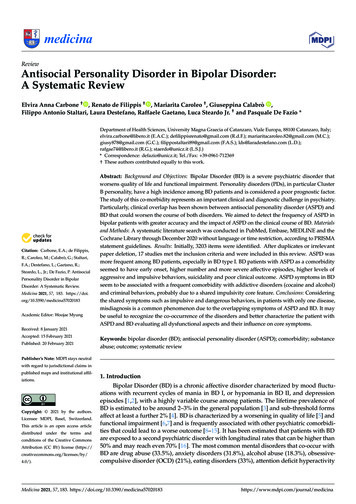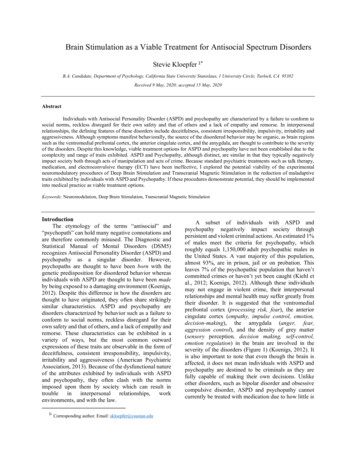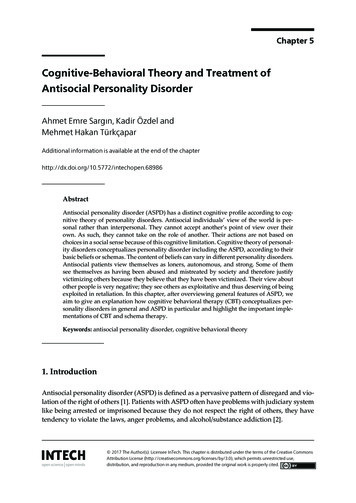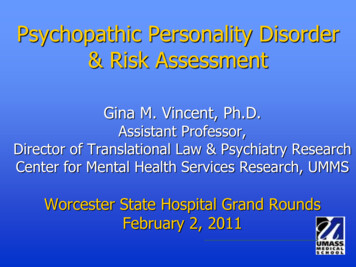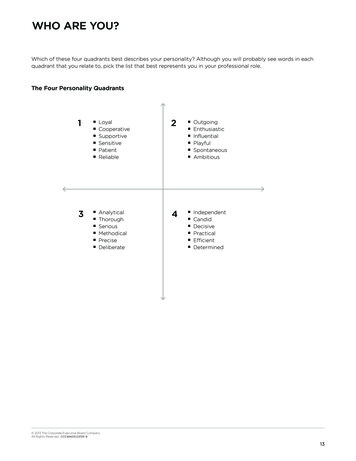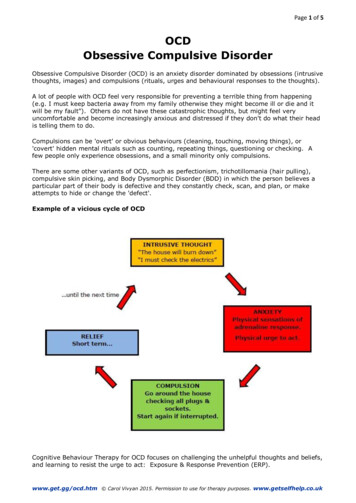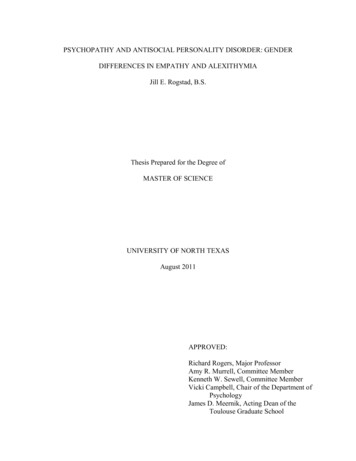
Transcription
PSYCHOPATHY AND ANTISOCIAL PERSONALITY DISORDER: GENDERDIFFERENCES IN EMPATHY AND ALEXITHYMIAJill E. Rogstad, B.S.Thesis Prepared for the Degree ofMASTER OF SCIENCEUNIVERSITY OF NORTH TEXASAugust 2011APPROVED:Richard Rogers, Major ProfessorAmy R. Murrell, Committee MemberKenneth W. Sewell, Committee MemberVicki Campbell, Chair of the Department ofPsychologyJames D. Meernik, Acting Dean of theToulouse Graduate School
Rogstad, Jill E. Psychopathy and antisocial personality disorder: Gender differences inempathy and alexithymia. Master of Science (Psychology), August 2011, 133 pp., 24 tables,references, 210 titles.Traditional conceptualizations of psychopathy highlight the importance of affectivefeatures of the syndrome in perpetuating social deviance. However, little research has directlyinvestigated the callousness that psychopathic offenders display toward society and their victims.The current study investigated the roles of empathy and alexithymia in psychopathy among maleand female incarcerated offenders, particularly in distinguishing psychopathy from antisocialpersonality disorder. Gender differences were also investigated. Regarding empathy, aspredicted, group differences were largest between psychopathic and non-psychopathic offenders;no reliable differences emerged between psychopathic and APD-only offenders. In contrast,alexithymia robustly distinguished between offenders with prominent psychopathic traits, thosewith only APD, and those with neither condition. Psychopathic females unexpectedly exhibitedslightly higher levels of alexithymia than their male counterparts, while empathic deficits wererelatively consistent across genders. These findings are discussed in terms of improvingassessment methods for the accurate identification and treatment of offenders with prominentpsychopathic features.
Copyright 2011byJill E. Rogstadii
TABLE OF CONTENTSPageLIST OF TABLES . viChapters1.INTRODUCTION .1Psychopathy: An Overview .1Conceptualization of Psychopathy.2Psychopathy and Antisocial Conduct .4Psychopathy and Antisocial Personality Disorder .8Gender Differences in Psychopathy.13Gender Differences in APD .15Prevalence of Female Psychopathy .16Severity of Female Psychopathy.18Measurement Bias .19Construct Validity and Factor Structure .20Violent and Nonviolent Recidivism in Female Psychopathy .22Affective Features of Psychopathy .23Emotion Processing Deficits .23Emotion Processing in Female Psychopathy .26Empathy and Psychopathy .28Gender Differences in Empathy.30Victim Empathy and Psychopathy .31Alexithymia and Psychopathy .33Current Study .38Research Questions and Hypotheses .392.METHOD .41Design .41Participants .41Research and Administrative Approval .41Materials .42iii
Psychopathy Checklist – Revised .42Structured Interview for DSM-IV Personality.42Self-Report Measures.43Procedure .47Inclusion and Exclusion Criteria.47Primary Research Procedures .483.RESULTS .50Refinement of the Sample.50Demographic Data .50Scale Properties .53Descriptive Data.55Primary Data Analysis .57Emotion in Psychopathy and APD .57Gender Differences in Emotion .69Discriminant Validity of Psychopathy and APD .804.DISCUSSION .82General and Victim Empathy.83Alexithymia.90Alexithymia in Psychopathy and APD .91Alexithymia in Female and Male Psychopathy .94Potential Interventions for Alexithymia and Psychopathy .96Emotional Memory in Psychopathy.98Discriminant Validity of Psychopathy and APD .101Limitations and Future Directions .103Concluding Remarks .106AppendicesA.A COMPARISON OF THE CRITERIA FOR PSYCHOPATHY ANDANTISOCIAL PERSONALITY DISORDER .108B.LIST OF NEGATIVE, NEUTRAL, AND POSITIVE WORDS USED ASSTIMULI IN THE PRESENT STUDY.111iv
C.AFFECTIVE DEFICITS? COMPARING NORMATIVE VALIDATIONSAMPLES TO THE CURRENT OFFENDER SAMPLE .113ENDNOTES .115REFERENCES .118v
LIST OF TABLESPage1.Cleckley’s (1941) Clinical Profile of a Psychopath.22.Two-Factor, Four-Facet Structure Conceptualization of the Psychopathy Checklist –Revised (PCL-R) .43.A Comparison of Male and Female Offenders on Demographic and Clinical Variables.514.Descriptive Categorization of PCL-R Psychopathy Total Scores by Gender.525.Reliability Estimates for Self-Report Measures .546.Relationships Between Psychopathy Facets, Empathy, and Alexithymia Among JailDetainees .567.General Empathy Deficits Across Psychopathy and APD Groups .588.Impression Management and Social Desirability Among Psychopathy and APD Groups.609.Relationships Among Psychopathy Facets and PDS Response Style Scales .6110.Victim Empathy Deficits in Offender Groups with Psychopathy and APD .6311.High Victim Empathy in Offender Groups with Psychopathy and APD .6312.Relationships Among General and Specific Affective Deficits in Offenders .6413.Differences in Alexithymia in Psychopathy and APD Groups .6614.Differences in General Affectivity in Psychopathy and APD Groups .6615.Differences in Emotional Memory Facilitation in Psychopathy and APD Groups .6816.Gender Differences in General Empathy in Offenders with Psychopathy and APD .7017.Gender-Specific Relationships between Psychopathy, APD, and General Empathy inOffenders.7118.Gender Differences in Victim Empathy in Offenders with Psychopathy and APD .7319.Gender-Specific Relationships between Psychopathy, APD, and Victim Empathy inOffenders.74vi
20.Gender-Specific Correlations Among General and Specific Affective Deficits in Maleand Female Offenders .7521.Gender Differences in Alexithymia in Offenders with Psychopathy and APD .7722.Gender-Specific Relationships between Psychopathy, APD, and Alexithymia Features.7823.Gender Differences in Emotional Memory Facilitation in Offenders with PsychopathyAPD.7924.Gender Differences in General Affectivity in Offenders with Psychopathy-APD .80vii
CHAPTER 1INTRODUCTIONPsychopathy: An OverviewPsychopathy as a clinical construct is characterized by a distinct constellation ofpersonality and behavioral anomalies. Specifically, psychopathic individuals are described aspossessing a malignant personality in which they are capable of presenting as interpersonallycharming but in reality are affectively shallow (e.g., Cleckley, 1941; Hare, 2003). They arefurther characterized by an impulsive, parasitic lifestyle and are prone to commit a wide array ofantisocial acts. They are generally viewed as feeling no empathy for their victims and no remorseor guilt for their crimes against other people. Some researchers and clinicians (e.g., Blair, 1995;Hare, 1996; Lykken, 1995) argue that marked deficits in affective experience amongpsychopathic individuals predispose them to commit particularly vicious and heinous crimes.This introduction is organized into four sections that address various issues of theassessment of psychopathy and associated affective features.1 First, I discuss currentconceptualizations of psychopathy and its influence in legal contexts, including the use ofpsychopathy in predicting antisocial conduct and violence. Second, I describe the differencesbetween psychopathy and antisocial personality disorder and examine the literature documentinggender differences in psychopathic offenders. Third, I elaborate on such gender differences in thecontext of affective deficits associated with psychopathy, particularly emotion processing,empathy, and alexithymia. Fourth, I introduce the current study that was designed to evaluategender differences in these affective features across diagnostic groups.1
Conceptualization of PsychopathyHervey Cleckley (1941) described the first set of criteria to typify the prototypicpsychopath in his seminal work, The Mask of Sanity. In his book, Cleckley described case studiesfrom his clinical practice that served as examples of individuals who exemplified thepsychopathic personality. Based on these case studies, he presented 16 criteria that focused on anumber of personality and behavioral features of the syndrome, placing particular emphasis onthe personality features of the disorder as core to the deviant characteristics his clients displayed.Table 1 presents Cleckley’s 16 criteria that produce his clinical profile of a psychopath.Table 1Cleckley’s (1941) Clinical Profile of a PsychopathSuperficial charm and good “intelligence”Absence of delusions and other signs of irrational thinkingAbsence of “nervousness” or psychoneurotic manifestationsUnreliabilityUntruthfulness and insincerityLack of remorse or shameInadequately motivated antisocial behaviorPoor judgment and failure to learn by experiencePathological egocentricity and incapacity for loveGeneral poverty in major affective reactionsSpecific loss of insightUnresponsiveness in general interpersonal relationsFantastic and uninviting behavior with drink and sometimes withoutSuicide rarely carried outSex life impersonal, trivial, and poorly integratedFailure to follow any life planIn line with Cleckley’s influential portrayal of psychopathic individuals, researchers haveattempted to produce measures of psychopathy that adequately capture the essence of Cleckley’sdescription. Of these assessment tools, Hare (1985, 1991, 2003) operationalized a portion ofCleckley’s criteria and created what is currently considered the “state of the art” measure for2
psychopathy assessment (Fulero, 1995). The Psychopathy Checklist – Revised (PCL-RTM; Hare,2003) has demonstrated good reliability and validity in a variety of forensic settings and acrossdiverse samples. Assessment of psychopathy using the PCL-R identifies key characteristics ofthe psychopathic syndrome, including interpersonal and affective features of the individual’spersonality as well as evidence of a socially deviant lifestyle.Psychopathy, as measured by the PCL-R, is conceptualized as having two or moreunderlying dimensions. Hare and colleagues (1990) proposed two crucial dimensions to typifythe construct: (a) interpersonal and affective personality features, and (b) antisocial behavior andsocial deviance (Harpur, Hakstian, & Hare, 1988). This two-dimensional model hasdemonstrated good construct and predictive validity. For the second dimension, a recent metaanalysis by Leistico, Salekin, DeCoster, and Rogers (2008) highlighted the ability of socialdeviance to predict antisocial conduct. More recently, the two dimensions have been expanded toinclude four essential facets. The personality dimension was split into interpersonal and affectivecomponents, while the behaviorally based social deviance dimension included both lifestyle andantisocial facets (Hare, 2003; Hare & Neumann, 2006). The PCL-R provides anoperationalization for these dimensions by proposed factor structures that comprehensivelycapture the latent psychopathy construct. Table 2 presents the 2-factor, 4-facet model andcorresponding items. This conceptualization in particular emphasizes the relatively equalimportance of each facet in providing a complete clinical picture of a psychopath.As an alternative to Hare’s model, Cooke and Michie (2001b) have proposed a differentconceptualization for the latent structure of psychopathy. They argued that a model that deemphasizes antisocial features is more in line with Cleckley’s original depiction of psychopathy.According to this model, a psychopathic individual displays an arrogant and deceitful3
interpersonal style, deficient affective experience, and an impulsive and irresponsible behavioralstyle.Table 2Two-Factor, Four-Facet Structure Conceptualization of the Psychopathy Checklist – Revised(PCL-R)Factor 1: Interpersonal/AffectiveInterpersonal facetAffective facetGlibness/superficialLack of remorse orcharmguiltGrandiose sense of selfShallow affectworthCallous/lack ofPathological lyingempathyFailure to acceptConning/manipulativeresponsibilityFactor 2: Lifestyle/AntisocialLifestyle facetAntisocial facetNeed for stimulation/Poor behavioralproneness to boredomcontrolsEarly behaviorParasitic lifestyleproblemsLack of realistic, longJuvenileterm goalsdelinquencyRevocation ofImpulsivityconditional releaseCriminalIrresponsibilityversatilityNote. Factor 2 of the PCL-R also includes two items that do not correspond to any of the four facets. These items are“promiscuous sexual behavior” and “many short-term marital relationships.”Unlike the original 2-factor and more contemporary 2-factor, 4-facet models, Cooke andMichie’s conceptualization emphasizes the importance of personality dimensions and suggeststhat antisociality is a consequence, rather than a defining characteristic, of psychopathy.However, subsequent research has suggested that antisocial aspects remain an important featureof psychopathy in both offenders (Hill, Neumann, & Rogers, 2004) and psychiatric patients(Vitacco, Neumann, & Jackson, 2005), particularly when evaluating individuals’ propensity forviolence.Psychopathy and Antisocial ConductResearchers, clinicians, and the general community tend to emphasize psychopathicindividuals’ proclivity to engage in violent crimes that shock and disturb both their specificvictims as well as the public in general. As an extreme example, the majority of serial killersmeets the criteria to be classified as psychopathic (Hare, 1993), representing the most heinous,4
serious form of violent offending. Although not all violent crime is committed by psychopathicindividuals, research has indicated that they are more prone than other offenders to commit adisproportionate number of violent offenses.The very nature of psychopathy and its associated characteristics seem to dispose theseindividuals toward more serious, violent crime. In their influential study of criminal psychopaths,Hare and McPherson (1984) found that psychopathic offenders are much more likely to engagein violent and aggressive behavior than are criminals in general. Other research with malecorrectional samples has generally supported this conclusion. For instance, Quinsey (1995)found that psychopathic group membership is associated with dangerousness in serious criminaloffenders perhaps by virtue of their “constellation of predatory, exploitative, and impulsivecharacteristics” (p. 123) that manifest through violent actions.Psychopathy tends to predict violence in criminal offenders (Kosson, Lorenz, &Newman, 2006) and psychiatric patients (Skeem & Mulvey, 2001). In their meta-analytic reviewof violence and psychopathy as measured by the PCL-R, Salekin, Rogers, and Sewell (1996)asserted that the PCL-R’s conceptualization of psychopathy is “unparalleled” and“unprecedented” in its ability to predict dangerousness, suggesting that psychopathy as aconstruct has wide applicability to forensic issues and, as such, should be considered as animportant factor within the context of the criminal justice system. The social deviance factor ofpsychopathy (Factor 2 of the PCL-R) has demonstrated particular usefulness in predicting bothgeneral recidivism and violent recidivism when compared to the interpersonal and affectivefactor (i.e., PCL-R Factor 1; Walters, 2003). Specifically, Leistico and colleagues (2008) in arecent meta-analysis corroborated the ability of Factor 2 to account for some differences (M d 5
.60) in risk for antisocial conduct in a diverse sample of 15,826 psychopaths and nonpsychopaths.Although research has generally supported the ability of psychopathy to predict violenceand aggression, the nature of this relationship varies across populations. The majority of thisresearch has focused on European American male offenders with the predictive validity ofpsychopathy measured by the PCL-R. However, moderator variables like race, gender,institutional setting (e.g., psychiatric or correctional), and assessment method for psychopathy(e.g., interview-based or file review) substantially influence the utility of social deviance whenassessing risk for violence and criminal conduct (Leistico et al., 2008). For instance, Leistico andcolleagues (2008) concluded that interpersonal and affective features of psychopathy appear toplay a larger role in explaining criminal behavior in females than in males. Similarly,psychopathic offenders’ likelihood to commit violent crimes may be moderated by cognitivefactors, such as intelligence (Heilbrun, 1982). On this point, Porter and Woodworth (2006)suggest that individuals with higher levels of intelligence may be able to devise nonviolentactions, while psychopaths with lower levels of intelligence are particularly prone to impulsiveviolent displays. Similar to findings with violence, research has demonstrated psychopathy’sintegral role in risk assessment for sex offenses and general recidivism in offender populations.Sex offenses. Several studies have established the prevalence of psychopathy in sexoffenders, particularly sexually violent offenders, who seem to pose a particular risk for thegeneral public and problems as well for the criminal justice system (e.g., Brown & Forth, 1997;Quinsey, Rice, & Harris, 1995) regarding recidivism and placement considerations. As a rule,child molesters tend to have much lower prevalence rates of psychopathy (approximately 1015%) than rapists or “mixed” sex offenders whose victims are both children and adults6
(approximately 40-50%). However, psychopathic sex offenders’ crimes tend to be more violentand sadistic than those of non-psychopathic sex offenders (Brown & Forth, 1997; Porter et al.,2000). In particular, psychopathy combined with deviant sexual arousal seems to be the mostpredictive combination when assessing sex offenders’ propensity for violent, sadistic sexualcrimes (Rice & Harris, 1995).Recidivism. Psychopathic offenders display an increased risk for recidivism afterconditional release from incarceration compared to their non-psychopathic counterparts. In theirstudy of 231 Canadian, white, male criminals released from prison on either parole or mandatorysupervision, Hart, Kropp, and Hare (1988) discovered that offenders with high levels ofpsychopathy (65.2%) were likely to recidivate more often than offenders with medium (48.9%)or low (23.5%) levels of psychopathy. Additionally, highly psychopathic offenders had thelowest probability of remaining in the community on conditional release for a one-year period. Infact, psychopathy was more predictive of conditional release violation than key backgroundvariables including age, release type, and criminal history. Likewise, Hemphill, Hare, and Wong(1998) demonstrated in a meta-analytic review of the literature that psychopathy was consistentlyamong the best predictors of recidivism across an array of inmate samples. Psychopathy hasconsistently been associated with both general and violent recidivism in both adult (Hemphill,Hare, & Wong, 1998) and youth offenders (Edens, Campbell, & Weir, 2007). Walters (2003)demonstrated in a recent meta-analysis that Factor 2 scores on the PCL-R in particularmoderately account for differences between psychopathic and non-psychopathic offenders forboth general (d .68) and violent (d .54) recidivism.In light of the empirical evidence for increased risk of violence and recidivism,psychopathy classification constitutes an influential factor in deciding the fate of offenders in the7
criminal justice system. Categorizing an offender as “psychopathic” may result in loss of libertyand, for some, prolonged or indefinite civil commitment (Kansas v. Hendricks, 1997). Therefore,it is imperative that psychopathic offenders are correctly classified and the designation ofpsychopathy is not inappropriately applied to the much larger, heterogeneous population ofoffenders with only antisocial personality disorder (Hare, 1999). In the next section, I highlightand evaluate the current controversies in the classification of psychopathy, specifically itsapplication to offenders with antisocial personality disorder and the generalization of researchwith psychopathic males to female offenders.Psychopathy and Antisocial Personality DisorderAntisocial personality disorder (APD) is the Axis II diagnosis most commonly associatedwith psychopathy among personality disorders recognized by the text revision to the fourthedition of the Diagnostic and Statistical Manual of Mental Disorders (DSM-IV-TR; AmericanPsychiatric Association [APA], 2000). In fact, the DSM-IV-TR uses the two termsinterchangeably as part of the same construct, stating that the pattern of behaviors that typifiesAPD “has also been referred to as psychopathy, sociopathy, or dissocial personality disorder”(APA, 2000, p. 702). A number of clinicians and researchers (e.g., Hare, 1996) have criticizedthe readiness to equate these two constructs when evidence indicates that the constructs are, infact, very different.Historically, the formulation of the diagnosis of APD was supposed to capture the samesuperficial and exploitative personality typified by Cleckley’s (1941) classical description of theprototypic psychopath. The second edition of the Diagnostic and Statistical Manual of MentalDisorders (DSM-II; APA, 1968) achieved this objective as it described persons exhibiting anantisocial personality as unsocialized, selfish, impulsive, remorseless, and callous individuals8
whose rationalization of their antisocial behavior precluded their ability to learn from experience(Hare, 1996). However, DSM-II’s lack of explicit diagnostic criteria led to a call for a revisionthat produced more behaviorally-specific criteria to facilitate enhanced reliability for assessmentand diagnosis (Spitzer, Endicott, & Robins, 1975).The third edition of the Diagnostic and Statistical Manual of Mental Disorders (DSM-III;APA, 1980) was published to alleviate such concerns by introducing an explicit list of criteria forthe diagnosis of APD. To facilitate reliability, the criteria focused almost exclusively uponbehavioral indicators of APD and omitted personality features of psychopathy, historicallyviewed as central to the disorder. This “construct drift” resulted in behavioral indicators thatfailed to capture the construct of psychopathy, the syndrome with which APD was originallyintended to be closely aligned (Hare, 1996). Conceptualizations of APD in DSM-III and itssubsequent revisions have produced interrater reliability estimates ranging from adequate togood in research and clinical practice (Mellsop, Varghese, Joshua, & Hicks, 1982; Widiger et al.,1996). However, Hare (1996) described APD as a reliable diagnosis with “dubious validity, acategory that lacked congruence with traditional conceptions of psychopathy” (p. 29).To date, the general consensus suggested the consistent failure of APD to achieve thesame predictive and clinical utility embodied by the psychopathy construct in forensicpopulations. However, recent research by Rogers and Rogstad (2010) calls into question thisassumption, highlighting the literature’s consistent failure to consider competing hypotheses withregards to APD and psychopathy when investigating antisocial conduct. This omission isparticularly salient in light of the intuitive similarities between an APD diagnosis and PCL-RFactor 2’s reliance on more observable behavioral indicators of antisociality. Not surprisingly,with APD’s de-emphasis of central affective features, its diagnosis in forensic populations has9
consistently failed to achieve the same predictive and clinical utility embodied by thepsychopathy construct. Notably, it appears that the interpersonal and affective features of Factor1 of psychopathy are particularly discriminating with respect to psychopathic individuals’limited amenability to treatment as well as emotion and information-processing deficits (Blair,1995; Hare, 1996; Hare, Hart, & Harpur, 1991; Vanman, Mejia, Dawson, Schell, & Raine,2003). McDermott and colleagues (2000) further suggest that the personality features included inthe construct of psychopathy predispose these individuals to engage in antisocial behavior.However, the criteria for APD do not include the majority of these discriminating core features.Criticisms of DSM-III and DSM-III-R’s overreliance upon explicit behavioral criteria todiagnose APD led researchers of the American Psychiatric Association Axis II Work Group toperform extensive field trials in an attempt to bring APD more in line with traditionalconceptualizations of psychopathy (Widiger et al., 1996). For the DSM-IV, the field trialsincluded alternative sets for potential APD criteria administered via semi-structured interviews:(a) behaviorally based criteria from DSM-III-R, (b) personality and behavioral criteria borrowedfrom the tenth edition of the International Classification of Diseases (ICD-10), and (c) 10 PCLR items. Results of the field trial indicated that the interpersonal and affective features presentedfor inclusion by the ICD-10 and modified PCL-R diagnostic sets achieved similar reliabilities tothe
psychopathic personality. Based on these case studies, he presented 16 criteria that focused on a number of personality and behavioral features of the syndrome, placing particular emphasis on the personality

